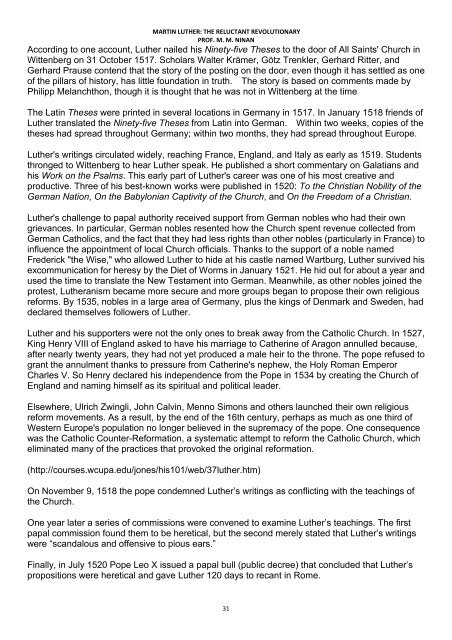Martin Luther
Create successful ePaper yourself
Turn your PDF publications into a flip-book with our unique Google optimized e-Paper software.
MARTIN LUTHER: THE RELUCTANT REVOLUTIONARY<br />
PROF. M. M. NINAN<br />
According to one account, <strong>Luther</strong> nailed his Ninety-five Theses to the door of All Saints' Church in<br />
Wittenberg on 31 October 1517. Scholars Walter Krämer, Götz Trenkler, Gerhard Ritter, and<br />
Gerhard Prause contend that the story of the posting on the door, even though it has settled as one<br />
of the pillars of history, has little foundation in truth. The story is based on comments made by<br />
Philipp Melanchthon, though it is thought that he was not in Wittenberg at the time<br />
The Latin Theses were printed in several locations in Germany in 1517. In January 1518 friends of<br />
<strong>Luther</strong> translated the Ninety-five Theses from Latin into German. Within two weeks, copies of the<br />
theses had spread throughout Germany; within two months, they had spread throughout Europe.<br />
<strong>Luther</strong>'s writings circulated widely, reaching France, England, and Italy as early as 1519. Students<br />
thronged to Wittenberg to hear <strong>Luther</strong> speak. He published a short commentary on Galatians and<br />
his Work on the Psalms. This early part of <strong>Luther</strong>'s career was one of his most creative and<br />
productive. Three of his best-known works were published in 1520: To the Christian Nobility of the<br />
German Nation, On the Babylonian Captivity of the Church, and On the Freedom of a Christian.<br />
<strong>Luther</strong>'s challenge to papal authority received support from German nobles who had their own<br />
grievances. In particular, German nobles resented how the Church spent revenue collected from<br />
German Catholics, and the fact that they had less rights than other nobles (particularly in France) to<br />
influence the appointment of local Church officials. Thanks to the support of a noble named<br />
Frederick "the Wise," who allowed <strong>Luther</strong> to hide at his castle named Wartburg, <strong>Luther</strong> survived his<br />
excommunication for heresy by the Diet of Worms in January 1521. He hid out for about a year and<br />
used the time to translate the New Testament into German. Meanwhile, as other nobles joined the<br />
protest, <strong>Luther</strong>anism became more secure and more groups began to propose their own religious<br />
reforms. By 1535, nobles in a large area of Germany, plus the kings of Denmark and Sweden, had<br />
declared themselves followers of <strong>Luther</strong>.<br />
<strong>Luther</strong> and his supporters were not the only ones to break away from the Catholic Church. In 1527,<br />
King Henry VIII of England asked to have his marriage to Catherine of Aragon annulled because,<br />
after nearly twenty years, they had not yet produced a male heir to the throne. The pope refused to<br />
grant the annulment thanks to pressure from Catherine's nephew, the Holy Roman Emperor<br />
Charles V. So Henry declared his independence from the Pope in 1534 by creating the Church of<br />
England and naming himself as its spiritual and political leader.<br />
Elsewhere, Ulrich Zwingli, John Calvin, Menno Simons and others launched their own religious<br />
reform movements. As a result, by the end of the 16th century, perhaps as much as one third of<br />
Western Europe's population no longer believed in the supremacy of the pope. One consequence<br />
was the Catholic Counter-Reformation, a systematic attempt to reform the Catholic Church, which<br />
eliminated many of the practices that provoked the original reformation.<br />
(http://courses.wcupa.edu/jones/his101/web/37luther.htm)<br />
On November 9, 1518 the pope condemned <strong>Luther</strong>’s writings as conflicting with the teachings of<br />
the Church.<br />
One year later a series of commissions were convened to examine <strong>Luther</strong>’s teachings. The first<br />
papal commission found them to be heretical, but the second merely stated that <strong>Luther</strong>’s writings<br />
were “scandalous and offensive to pious ears.”<br />
Finally, in July 1520 Pope Leo X issued a papal bull (public decree) that concluded that <strong>Luther</strong>’s<br />
propositions were heretical and gave <strong>Luther</strong> 120 days to recant in Rome.<br />
31

















